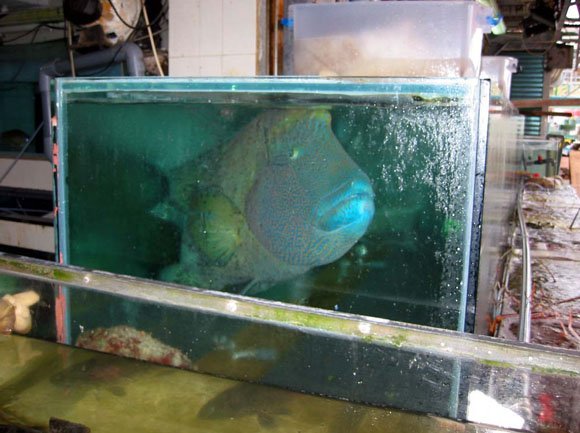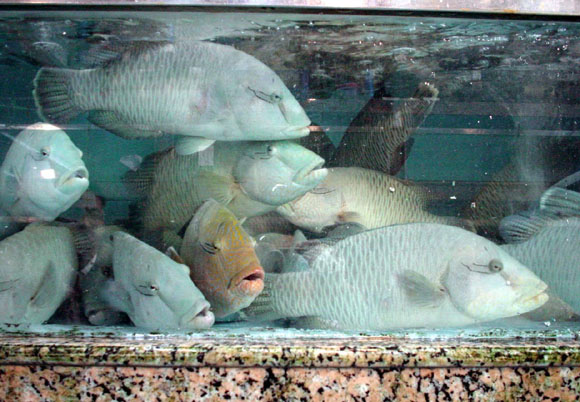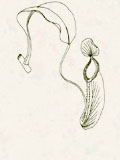
|
|
Vertebrates (pdf)
Preserving a gentle reef fish giant (pdf)
by
Yvonne Sadovy
IUCN Specialist Group for Groupers and Wrassesy
Not so very long ago, the idea of a commercially important marine fish going extinct was considered highly unlikely, if not impossible. The assumption was that marine species are so widely dispersed and so fecund (productive of eggs) that there would always be places they could not be found, and that all those eggs endowed them with limitless capacity for recovery. Some biologists still argue that extinction is not possible, stating, in support of this view, that no marine fish has ever been known to go extinct from exploitation. Only time will tell whether or not they are right. However, we have learned enough about declines in populations of many fish species to know that these can be threatened with disappearance (or ‘extirpation’), even if the species as a whole is not (Dulvy et al. 2003). Moreover, we now know that high egg numbers and wide geographic distribution are no insurance against serious depletions; the cod (Gadus morhua) and the southern bluefin tuna (Thunnus maccoyii) has shown us that. In any event, loss of single populations is the first step towards biological extinction and it makes little sense to wait until it is too late to see who is right.
 |
| Fig. 1 Large humphead wrasse in small tank in Hong Kong. (Photo: Liu Min) |
Many fish species for which serious declines have been noted are large and long-lived, often with life spans of several decades or more. Such species are likely to have rather low replacement rates and hence are particularly vulnerable because they are unable to withstand heavy fishing pressure. In other words, if too many fish are removed too quickly, the population will decline and, without management, dwindle and possibly disappear. This is especially likely if the species is particularly valuable because even if it becomes harder to catch, its value remains a big incentive to continue fishing. As just one example, a single large tuna can sell for US$40,000 or more. To make matters worse, increasing rarity may be associated with higher retail prices.
One of the largest and most valuable of all reef fishes is the humphead, or Napoleon, wrasse, Cheilinus undulatus, known better to many in Hong Kong as the ‘So Mei’ (Fig. 1). This species is a small but important part of the international trade in live reef fish for which Hong Kong is a major demand centre: at times its retail price has reached US$150/kg. So there is a lot of interest from traders and fishermen to find and market this species and, largely as a result of the trade in live reef fish, the humphead wrasse has declined in many areas. Even though it is widely distributed across the Indo-Pacific, sub-adults or juveniles, preferred as being a good ‘plate-size’ fish in restaurants, often occur inshore and are easy to overfish (Fig. 2). The species reaches 2 m in length and can live at least 30 years. It is, therefore, rather susceptible to fishing, and, as a result of demand, is disappearing.
Due to concern for this species, the humphead wrasse was listed under Appendix II of the Convention on International Trade in Endangered Species (CITES at www.CITES.org) in October, 2004 (Sadovy et al., 2003; www.humpheadwrasse.info). This was an historic listing because it is one of the first commercially important marine fish species to be so classified. A species on CITES Appendix II in international trade must be monitored and can still be exported if it has been sustainably caught in the source country. Many people think that CITES is all about banning species in trade. In the case of Appendix II, however, this is not the case; listed species can only be exported if they are captured at sustainable levels and so CITES promotes and fosters sustainable use for vulnerable species.
 |
| Fig. 2. ‘Plate-sized’ humphead wrasse, ready for the plate. (Photo: Valerie Ho) |
Listing of commercial fishes, historically, has rarely occurred under CITES which many governments feel is not a suitable convention for fish. With the humphead listing, however, the mood is clearly changing. The Food and Agriculture Organization (FAO) of the United Nations was previously seen as the only appropriate body for dealing with fishes, but the FAO is not directly involved in management and tends to deal more with the large, more economically important, global fisheries, not reef fish species or those of more minor global significance. CITES, therefore, is an excellent mechanism for moving towards the sustainable use of species, like the humphead wrasse, which science has clearly shown to be threatened and in need of attention, and is not otherwise effectively protected. The recent listing was considered a landmark for fish conservation and sustainable management because it was the first to receive strong support from countries that normally oppose applying CITES for fishes. Let’s hope that this listing also casts a spotlight on the need to better manage reef fish fisheries in general. These must continue to support the livelihoods and lives of the millions of fishermen living in coastal areas around the tropics, and will, as a result, allow us to eat reef fish that are sustainably caught, guilt-free.
Bibliography
Dulvy, N.K., Sadovy, Y. & Reynolds, J.D. (2003). Extinction vulnerability in marine populations. Fish and Fisheries 4:25-64
Sadovy, Y, Kulbicki M., Labrosse P, Letourneur Y., Lokani, P. & Donaldson, T.J. (2003). The humphead wrasse, Cheilinus undulatus: synopsis of a threatened and poorly known giant coral reef fish. Reviews in Fish Biology and Fisheries 13 (3):327-364.
|
|
P.5-6 |
|
Porcupine! |
 Copyright © 2000 |
